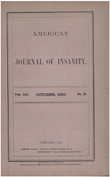Low plasma gamma-aminobutyric acid levels during the late luteal phase of women with premenstrual dysphoric disorder
Abstract
OBJECTIVE: Plasma gamma-aminobutyric acid (GABA) levels have been reported to be low in some patients with major depressive disorder. Premenstrual dysphoric disorder is often associated with major depressive disorder. Therefore, the authors sought to determine whether women with premenstrual dysphoric disorder with or without prior major depressive disorder also had low plasma GABA levels. METHOD: Plasma GABA levels were measured in 27 women with premenstrual dysphoric disorder and 21 comparison women during the the mid-follicular and late luteal phases of the menstrual cycle. RESULTS: In comparison women, plasma GABA levels increased from the mid-follicular to the late luteal phase. Women with premenstrual dysphoric disorder and a past history of major depressive disorder had low plasma GABA levels during both phases. In women with premenstrual dysphoric disorder but no past major depressive disorder, plasma GABA levels decreased from the nonsymptomatic, mid-follicular phase to the symptomatic, late luteal phase. CONCLUSIONS: Decreased GABA function may represent a common biological link between subtypes of depressive and premenstrual dysphoric disorders. A trait in major depressive disorder and a state- dependent decrease in premenstrual dysphoric disorder might imply a possible continuum between the two disorders.
Access content
To read the fulltext, please use one of the options below to sign in or purchase access.- Personal login
- Institutional Login
- Sign in via OpenAthens
- Register for access
-
Please login/register if you wish to pair your device and check access availability.
Not a subscriber?
PsychiatryOnline subscription options offer access to the DSM-5 library, books, journals, CME, and patient resources. This all-in-one virtual library provides psychiatrists and mental health professionals with key resources for diagnosis, treatment, research, and professional development.
Need more help? PsychiatryOnline Customer Service may be reached by emailing [email protected] or by calling 800-368-5777 (in the U.S.) or 703-907-7322 (outside the U.S.).



